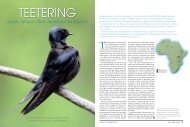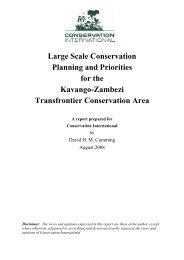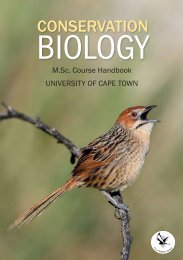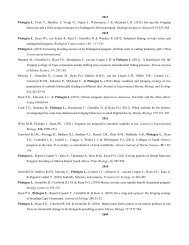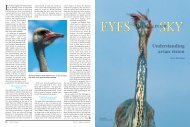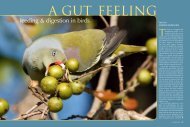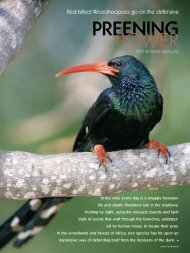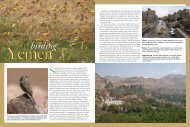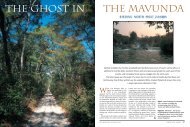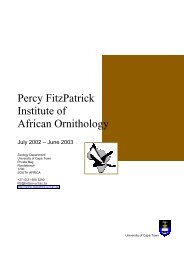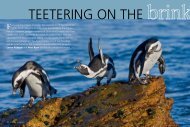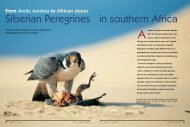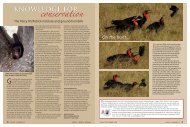Cape Parrot - Percy FitzPatrick Institute of African Ornithology
Cape Parrot - Percy FitzPatrick Institute of African Ornithology
Cape Parrot - Percy FitzPatrick Institute of African Ornithology
Create successful ePaper yourself
Turn your PDF publications into a flip-book with our unique Google optimized e-Paper software.
steve boyes<br />
graham russell<br />
<strong>Cape</strong> <strong>Parrot</strong> – Sa’s most endangered bird?<br />
The <strong>Cape</strong> <strong>Parrot</strong> Poicephalus robustus is endemic to<br />
South Africa, where it is confined to the eastern<br />
Afromontane forests. The population has collapsed<br />
over the last 50–100 years, and today fewer than 1500<br />
parrots remain in the wild. These two statistics combine<br />
to make the <strong>Cape</strong> <strong>Parrot</strong> Critically Endangered. Worldwide,<br />
parrots have the most threatened species <strong>of</strong> any bird<br />
family: more than 90 <strong>of</strong> the world’s 332 parrot species are<br />
threatened with global extinction. More than 70 <strong>of</strong> these<br />
are threatened by habitat loss, fragmentation or degradation,<br />
and 39 species are threatened by the wild-caught bird<br />
trade, mostly illegally.<br />
The <strong>Cape</strong> <strong>Parrot</strong> is one <strong>of</strong><br />
Worldwide, parrots<br />
have the most<br />
threatened species<br />
<strong>of</strong> any bird family:<br />
more than 90 <strong>of</strong> the<br />
world’s 332 parrot<br />
species are threatened<br />
with global extinction<br />
28 parrot species threatened<br />
by both habitat loss and trade.<br />
Because the <strong>Cape</strong> <strong>Parrot</strong> is one<br />
<strong>of</strong> South Africa’s most threatened<br />
endemic species, researchers<br />
at the <strong>Percy</strong> <strong>FitzPatrick</strong> <strong>Institute</strong><br />
have taken on the challenge <strong>of</strong><br />
helping to save this iconic species<br />
from extinction.<br />
(Above, left) Illegal trapping for the cage-bird trade is a major and<br />
ongoing threat to wild <strong>Cape</strong> <strong>Parrot</strong>s.<br />
Pioneering work by Jack Skead <strong>of</strong> the <strong>Percy</strong> <strong>FitzPatrick</strong><br />
<strong>Institute</strong> and Olaf Wirminghaus <strong>of</strong> the University <strong>of</strong><br />
KwaZulu-Natal showed that <strong>Cape</strong> <strong>Parrot</strong>s are strongly tied<br />
to Afromontane mistbelt yellowwood (Podocarpus) trees for<br />
food and nesting sites. Yellowwoods produce high-quality<br />
hardwood, much in demand for the furniture business,<br />
and have been logged intensively for more than 300 years.<br />
Continued logging by local communities and regulated<br />
harvesting by the government means that the ongoing loss<br />
<strong>of</strong> yellowwoods remains a ‘clear and present danger’.<br />
<strong>Cape</strong> <strong>Parrot</strong>s are further threatened by disease – especially<br />
the airborne Psittacine Beak and Feather Disease (PBFD)<br />
– and by illegal capture for the bird trade. Historically,<br />
<strong>Cape</strong> <strong>Parrot</strong>s were popular cage birds until the population<br />
collapse towards the middle <strong>of</strong> the 20th Century. Recently,<br />
there has been a resurgence in the demand for <strong>Cape</strong><br />
<strong>Parrot</strong>s in captivity fuelled by a combination <strong>of</strong> rarity and<br />
a massive rise in their market value. Of additional grave<br />
concern are several confirmed reports <strong>of</strong> full-blown PBFD<br />
symptoms in wild <strong>Cape</strong> <strong>Parrot</strong>s in the Eastern <strong>Cape</strong>: several
graham russell (3)<br />
<strong>of</strong> these infected birds have already died. We need to act<br />
now to determine the causes <strong>of</strong> this latter problem before<br />
it is too late, because vaccines have been developed that<br />
could possibly be used to mitigate future outbreaks. One<br />
<strong>of</strong> our research aims is to capture as many <strong>Cape</strong> <strong>Parrot</strong>s as<br />
possible to take blood for screening and disease testing,<br />
thus helping us understand and combat this threat.<br />
Our post-doctoral researcher working on the Amathole<br />
<strong>Cape</strong> <strong>Parrot</strong> Project in the Eastern <strong>Cape</strong> spent five years<br />
studying the ecology <strong>of</strong> Meyer’s <strong>Parrot</strong>s P. meyeri in Botswana’s<br />
Okavango Delta in preparation for undertaking this<br />
study on the <strong>Cape</strong> <strong>Parrot</strong>. Our objectives are simple. Based<br />
on sound scientific research into their feeding and breeding<br />
behaviour, coupled with an in-depth study <strong>of</strong> the condition<br />
and productivity <strong>of</strong> the remaining intact Afromontane forest<br />
patches, we aim to develop and implement a conservation<br />
plan that will protect this species into perpetuity.<br />
We will also be taking to the air to track <strong>Cape</strong> <strong>Parrot</strong>s on<br />
their long feeding forays between forest patches, coastal<br />
Wild <strong>Cape</strong> <strong>Parrot</strong>s with advanced symptoms <strong>of</strong> PBFD likely brought on by<br />
poor-quality food.<br />
areas and ‘artificial’ food resources (e.g. pecan nut orchards).<br />
From our bird’s eye view in the microlight, and in<br />
conjunction with our on-the-ground forest surveys, we also<br />
plan to survey forest health using high-definition photography<br />
to develop rapid, accurate and repeatable forest<br />
assessment techniques.<br />
The plight <strong>of</strong> the <strong>Cape</strong> <strong>Parrot</strong> is immediate and<br />
serious, and we have already started this project<br />
with a researcher based in the Amathole Mountains.<br />
Some <strong>of</strong> the costs associated with the project<br />
are high, especially the aerial tracking <strong>of</strong> birds fitted<br />
with radio transmitters. The initial phase <strong>of</strong> the project<br />
is planned to last three years. Although some funding<br />
is already committed to the project, we are urgently<br />
seeking additional sponsorship <strong>of</strong> some $70 000.<br />
Contact Pr<strong>of</strong> Phil Hockey, Director, <strong>Percy</strong> <strong>FitzPatrick</strong> <strong>Institute</strong> and DST/NRF Centre <strong>of</strong> Excellence<br />
E-mail phil.hockey@uct.ac.za • Tel. +27 21 650 3291 • Fax +27 21 650 3295 • Website www.fitzpatrick.uct.ac.za



